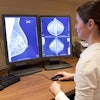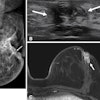Monday, December 1 | 3:20 p.m.-3:30 p.m. | SSE02-03 | Room E450A
How useful is MR in staging newly diagnosed breast cancer detected by digital breast tomosynthesis (DBT)? It's a question that needs to be considered, according to researchers from the University of Pennsylvania.Dr. Amy Chudgar and colleagues compared the utility of breast MR in two groups of patients with newly diagnosed breast cancer. The study included data from 24,563 patients screened by DBT between October 2011 and November 2013 and 10,751 patients screened by digital mammography between September 2010 and August 2011.
Of the DBT-screened women, 235 had a subsequent breast MR exam; 83 of these exams were to stage newly diagnosed breast cancer. In the digital mammography group, 83 women had subsequent MR studies, 23 of which were for staging newly diagnosed breast cancer. The two groups of MR-staged women were what Chudgar's group used for the study population.
Their study showed that MR detected additional disease in eight (10%) of the 83 DBT-screened women. MR's false-positive rate in this group was 14%, and in 76% of these cases, MR did not add any additional information, Chudgar and colleagues wrote. In the digital mammography group, seven (30%) of the 23 staging MR cases were true positives, three (13%) were false positives, and 13 (57%) offered no additional information.
Although MR finds additional cancers in women with new cancer diagnoses who were screened with digital mammography or DBT, its positive impact is less in those who received DBT screening. This suggests that its role in screening for additional disease should be considered carefully, Chudgar and colleagues concluded.




















